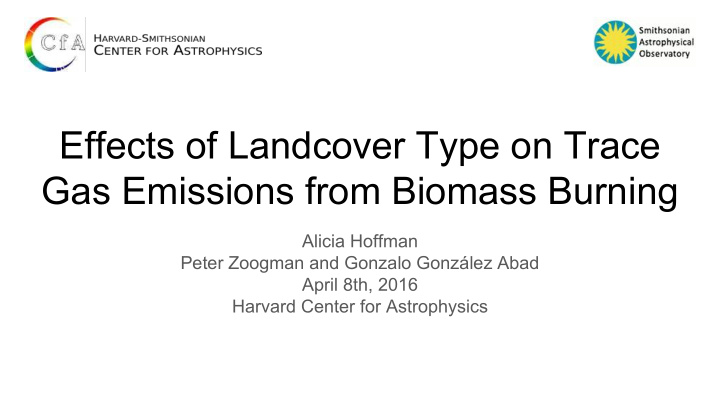



Effects of Landcover Type on Trace Gas Emissions from Biomass Burning Alicia Hoffman Peter Zoogman and Gonzalo González Abad April 8th, 2016 Harvard Center for Astrophysics
Trace gases in the atmosphere - Many negative impacts of VOCs in atmosphere: - Environment - Human health - Climate - Formaldehyde (HCHO) and glyoxal (CHOCHO) two trace gases - Anthropogenic and biogenic sources http://techalive.mtu.edu/envengtext/ch12_criteria.htm 2
Explanation of biomass burning events - Biomass burning: combustion of non- fossilized organic fuel - Fuel: portion of biomass that can burn - Natural or unnatural sources - Emissions depend on fire type, fuel type, meteorological conditions, other unknown factors 3 http://www4.ncsu.edu/~wahoffma/FireEcology/FireEcology.html
Fire type: flaming versus smoldering http://www.gettyimages.com/detail/video/fire-in-the-cornfield-after-harvest-burning-biomass-stock-footage/461956356 4 http://www.gettyimages.com/detail/video/fire-in-the-cornfield-after-harvest-burning-biomass-stock-footage/462087734
Environmental influence http://www4.ncsu.edu/~wahoffma/FireEcology/FireEcology.html 5
Tropical forest fire emissions Tropical Forest Savanna CO 2 (g/kg fuel) 1643 1686 1585 Isoprene (C 5 H 8 ) 0.13 0.039 0.38 Formaldehyde (HCHO) 1.73 0.73 2.08 NO x 2.55 3.9 3.11 Table modified from Akagi et al. 2011 Image: http://news.mongabay.com/2008/03/chinas-tropical-rainforests-decline-67-in-30-years/ 6
Savanna and grassland fire emissions Tropical Forest Savanna CO 2 (g/kg fuel) 1643 1686 1585 Isoprene (C 5 H 8 ) 0.13 0.039 0.38 Formaldehyde (HCHO) 1.73 0.73 2.08 NO x 2.55 3.9 3.11 Table modified from Akagi et al. 2011 Image: https://en.wikipedia.org/wiki/Savanna 7
Cropland and pasture fire emissions Tropical Forest Savanna CO 2 (g/kg fuel) 1643 1686 1585 Isoprene (C 5 H 8 ) 0.13 0.039 0.38 Formaldehyde (HCHO) 1.73 0.73 2.08 NO x 2.55 3.9 3.11 Table modified from Akagi et al. 2011 Image: http://farmindustrynews.com/business/top-7-tips-how-renegotiate-old-farmland-lease-or-find-new-one 8
Questions: 1) Is there a seasonal relationship between biomass burning and formaldehyde or glyoxal emissions? 2) Does landcover type influence formaldehyde and glyoxal concentrations? 3) Which landcover type is related to what chemical ratio signature? Why? 9
Data - Formaldehyde: SAO OMI HCHO retrieval (L3) [Gonzalez Abad et al., 2015] - Fire radiative power: MODIS active fire product from Aqua (L3, Collection 5) [Giglio et al. 2003] - Landcover: MODIS Land Cover Types Yearly L3 Global 0.05 Deg CMG - Glyoxal: SAO OMI CHOCHO retrieval (L3) [Chan Miller et al., 2014] - Temperature: ERA-Interim (reanalysis product) [Dee et al., 2011] - Years 2006-2007 10
11
Global 10˚N-10˚S all landcover types 12
Global 10˚N-10˚S all landcover types 13
Tropical forest 14
Savanna 15
Cropland 16
African tropical forests 10˚N-10˚S 17
African savanna 10˚N-10˚S 18
African croplands 10˚N-10˚S 19
Discussion of HCHO peak delay - Delay in savanna HCHO not from wind transport - Fire type and fire emissions don’t correlate - Above-ground fuel type and fire emissions don’t correlate - Below-ground fuel contribution unknown - Possible human intervention/causation Delmas et al. 1999 20
Further study of HCHO - South America - Divide Northern and Southern Hemispheres - Landcover maps - Soil types and below-ground fuel - Human influence in seasonality 21
African croplands - glyoxal 22
CO + HO 2 + products Glyoxal discussion O 2 + CHOCHO - CHOCHO + OH - Only 23% of CHOCHO uptake - Glyoxal variance w/ VOCs NO 3 OH - Isoprene and monoterpenes - Secondary organic aerosols - Other CHOCHO sinks soil N soil N - Soil nitrogen - Long-range transport of other reactive species? •OH + CHOCHO +O 2 → 2CO + HO 2 + H 2 O CHOCHO + NO 3 + O 2 → 2CO + HNO 3 + HO 2 23
Recommend
More recommend